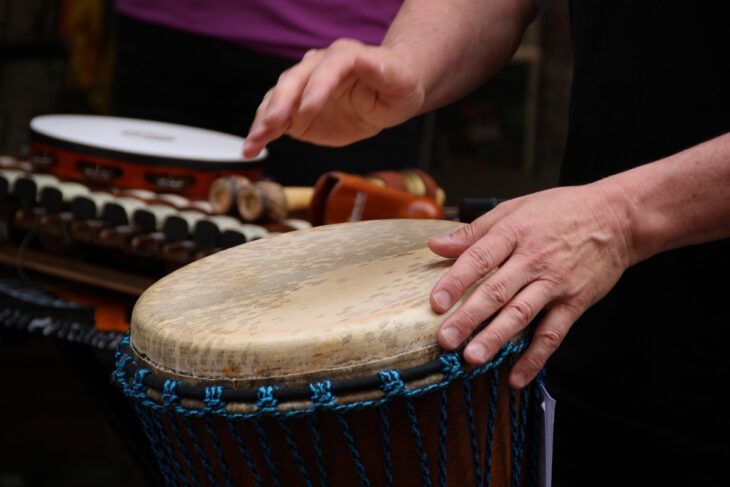These Tiny Things
Georgia
- Children
- Disability
- Young people
- Activities

A part of the project not mentioned here so far, though central, is
the work we have done directly with children. This has acted
as a model for staff members, who have observed, participated in
and, finally, run sessions. The needs, and the strengths,
children have revealed in the groups has formed the basis of the
training course and the development of the project.
Although the thirty children participating in
music sessions have shaped the project, the sessions themselves are
the hardest thing to write about. Perhaps the difficulty
comes because things that feel significant are small moments,
miniscule shifts, glancing, provisional interpretations and
glimpsed possibilities – nothing definite. Each child
responds moment to moment in his or her own particular way.
It is hard to generalise and perhaps that’s the
point.
Music therapists tend to write about their
work through case study examples; I am starting to see why.
If it is impossible to generalise – and when it comes to
human interactions perhaps it should be – case studies at
least allow us to be specific and definite about the unfolding of a
particular therapeutic relationship. In a similar spirit, I
wanted to mention a few tiny things that have stayed with
me:
An autistic boy spends most of the first three sessions at the back of
the hall, usually taking an instrument with him. We try to
stay in musical contact, responding to sounds he makes and using
his name. During the fourth session, he is able to take his
place in the circle.
A young woman with little speech, who staff members describe as
generally unresponsive outside the music room, joins in with a
familiar Georgian song. As it ends she lays a palm across her
breast bone. ‘Guli,’ she says. Heart.
A small girl called Mari spends most of the first session hiding her
face with her arm, as if blocking out strong sunlight. She
refuses all instruments and, thought she shows keen interest in
what is going on, any attention sent her way leads her to hide her
face again. By the fourth session, she reaches out to take
and play instruments offered to her and, at times, makes clear eye
contact.
A group of five children who share a lack of confidence and a
tendency to silence spontaneously develop a musical game. We
pass an imaginary object around the circle, which changes shape
from person to person, ‘speaking’ for the child.
In one child’s hands it is a scary monster, growling, in
another’s it becomes a cat, miaowing. The children are
engaged, laughing and delightfully creative. During the
following session this game develops quite naturally into a group
vocal improvisation, where each child has a voice and can
experiment within the game’s structure.
Though moments like this are just a start, their significance is felt by
staff attending sessions. The women see the children’s
usual behaviour day to day, so they are alive to any new
responses. They are quick to notice if a child becomes more
vocal, or seems less anxious, or begins to take more
initiative.
One of the carers tells us she has seen a boy
who lacks confidence in the classroom introducing a musical name
game to his classmates. Another tells us that a girl she has
worked with during music now seeks eye contact with her when they
pass in the corridor. She feels this is a sign of a
developing relationship, sustained between
sessions.
The more these women see what music can offer
here, the greater their enthusiasm to develop the work. We
begin to talk about how the sessions might change over time, and
about potential therapeutic goals for children. Staff
commitment is vital because the success of the project depends on
these busy carers and teachers choosing to continue the work
despite the extra pressure this will put on them – and on the
school’s resources.
We are in Georgia for three weeks, only long
enough to see glimpses. We are hopeful, but every seeming
development for a child feels provisional; we don’t have time
to explore and test our hunches.
We plan to offer support, both virtually from
Scotland and through regular follow-up visits. In between
times, staff at the school will need to hold a sense of
what’s possible, not only to give the work shape and
direction but also to motivate them to continue.
When we were planning this project, I had all sorts of grand
ideas. I hoped we would be able to facilitate an exchange of
knowledge between those engaged in traditional Georgian practices
of healing through song and professional music therapists in the
UK. The reality has been different from the plan, less neatly
poised, and I hope this is because we have responded to the context
and to actual need.
Perhaps the best thing we can do in a short
project like this is to recognise and draw out the skills these
women already have. Many of them have worked at the school
for several years and have a wealth of experience in caring and
teaching roles. They show an ease in their interactions with
children, a good-humoured confidence and sharp intuitive sense.
We bring a specific way of thinking about music and about
nonverbal interaction, one that prioritises listening over
directing, and shared creativity over authority.
Though not in the way I had imagined, this
project has been a real exchange between cultures. We have
learned as much as we have taught.
I hope and believe this is just the beginning.
Related projects
-
On-site skill-sharing: Public School No.200 (Tbilisi) 2011
Georgia
- Children
- Disability
- Young people
